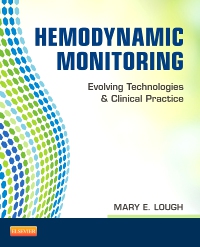
Hemodynamic Monitoring, 1st Edition
Paperback

Now $82.44
An evidence-based guide to hemodynamic monitoring procedures and patient care, Hemodynamic Monitoring: Evolving Technologies & Clinical Practice describes invasive, non-invasive, and minimally invasive techniques in monitoring blood pressure and oxygen levels within the circulatory system. It provides a clear, illustrated discussion of the anatomy and physiology related to hemodynamics, explains the technologies involved in each measurement, and includes quick-reference tables of normal and abnormal values. Written by cardiovascular nursing expert Mary E. Lough, Hemodynamic Monitoring is a detailed, comprehensive text designed for critical care nurses and respiratory therapists.
-
- Case Studies in each clinical chapter include a patient scenario with assessment details, allowing you to envision real-life patient care and prepare for adverse outcomes or complications.
- Coverage of patient safety includes a discussion of important measures that will help you provide safe and effective patient-centered care.
- UNIQUE! Coverage of patient comfort includes a discussion of methods to increase patient comfort during invasive procedures.
- Clinical Reasoning Pearls provide practical advice from experts and describe how to implement a procedure or improve patient care.
- A table of Important Values and Formulas is located inside the back cover for quick and easy reference.
-
PART 1: FUNDAMENTALS OF HEMODYNAMIC MONITORING
1. Physiological Principles of Hemodynamic Monitoring
2. Physical Assessment and Hemodynamic Monitoring
3. Arterial Pressure Monitoring
4. Central Venous Pressure Monitoring
5. Pulmonary Artery Pressure and Thermodilution Cardiac Output Monitoring
6. Oxygenation and Acid Base Balance Monitoring
7. Venous Oxygen Saturation Monitoring
8. Capnography in Clinical Practice
9. Vasoactive MedicationsPART 2: NON-INVASIVE AND MINIMALLY INVASIVE HEMODYNAMIC MONITORING
10. Doppler Hemodynamic Monitoring
11. Non-Invasive and Minimally Invasive Hemodynamic Monitoring: Ultrasound-Based Technologies
12. Arterial Waveform and Pressure-Based Technologies
13. Implantable Hemodynamic MonitoringPART 3: CLINICAL APPLICATIONS OF HEMODYNAMIC MONITORING
14. Hemodynamics of Mechanical Ventilation and Acute Respiratory Distress Syndrome
15. Hemodynamic Impact of Mechanical Circulatory Support
16. Hemodynamic Management Following Cardiac Surgery
17. Hemodynamic Management in Heart Failure and Cardiogenic Shock
18. Hemodynamics of Acute Right Heart Failure and Pulmonary Hypertension
19. Hemodynamic Management in Hypovolemia and Trauma
20. Hemodynamic Management of Sepsis
21. Hemodynamic Management in Neurocritical Care
22. Goal-Directed Hemodynamic Therapy

 as described in our
as described in our 